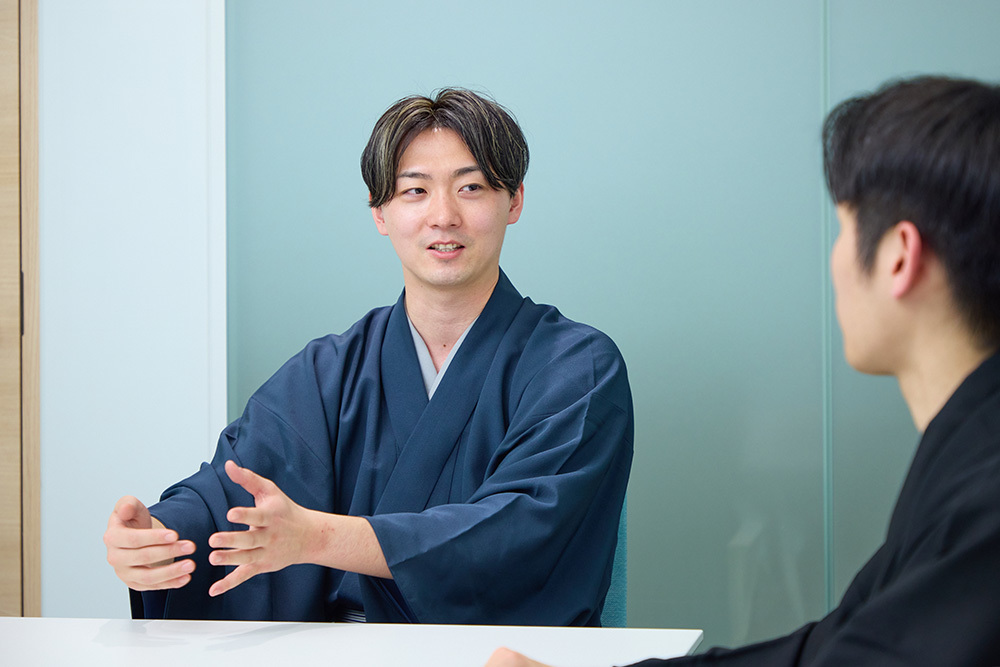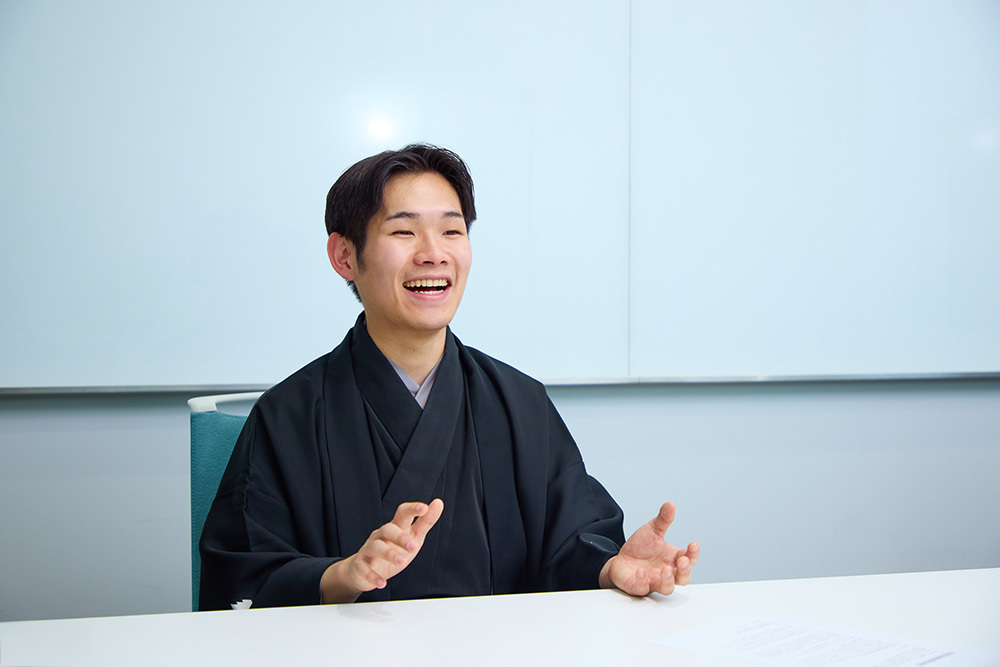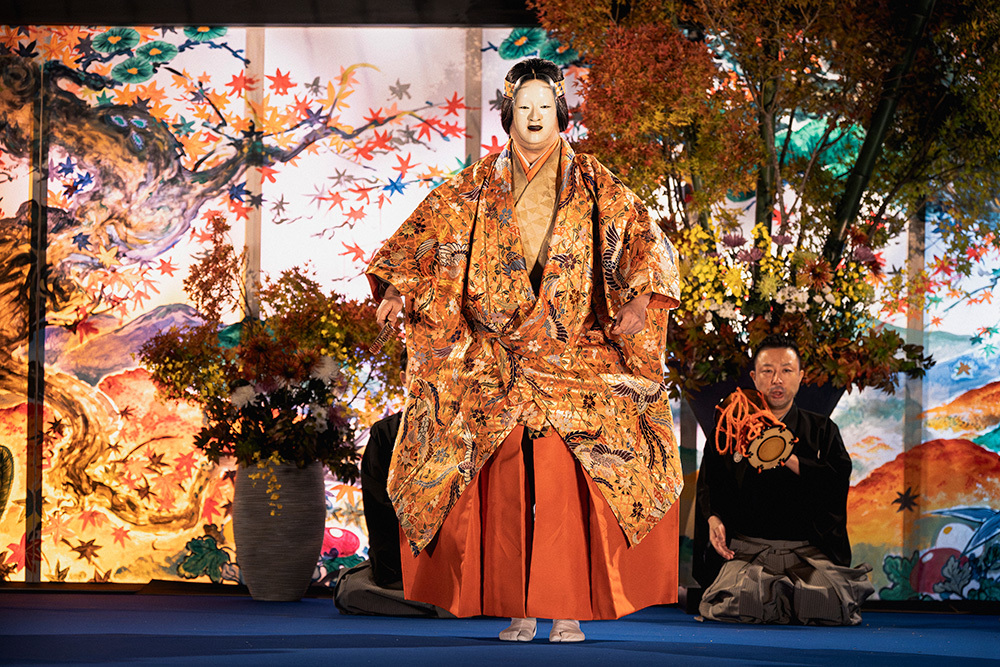Using passion as a driving force to convey the appeal of Japan's traditional culture

Hiroaki Ogasawara
Noh actor specializing in kyōgen of the Izumi school

Ryōsuke Ōiwa
Dentsu Inc.
Turning personal passion into professional strength—our guests this time are Kyogen performer Hiroaki Ogasawara, who works to spread Japanese traditional culture to younger generations, and Dentsu Inc. planner/producer Ryosuke Oiwa.
What are Mr. Ogasawara, who continues as a kyogen performer without the obligation to inherit the family tradition, and Mr. Oiwa, who channels his passion for "Japanese traditional culture" into producing events, actually doing in their professional lives?
We hope this article offers insights into transforming corporate culture by harnessing employees' passions.

Driven by a passion for "Japanese traditional culture" and a sense of self-appointed mission
──First, please introduce yourself, Mr. Oiwa.
Oiwa: As a planner/producer at Dentsu Inc., I handle marketing strategy development, PR planning, and event/space production for various clients. Seeking deeper involvement in culture-related work, I relocated from Tokyo to Kyoto in January 2025. I also participate in Dentsu Inc.'s internal project "BUKATSU" ( details here ), which fosters employee connections based on shared passions, visualizes collective knowledge, and connects it to work. I belong to the "Japanese Traditional Culture Club."
──What sparked your interest in Japan's traditional culture, Mr. Oiwa?
Oiwa: During my third year of university, while studying abroad in Paris, I was invited to a French person's home tea room after sitting next to them by chance in a café. That was where I first discovered the charm of the tea ceremony. After that, I began studying the Sōhenryū Shōden-an school of tea ceremony in Tokyo and became deeply immersed in the appeal of Japanese traditional culture. Now, my hobbies include attending lessons and experiences in various Japanese traditional arts like ikebana, the taiko drum of Noh theater, and zazen meditation.
──Thank you. Now, could you tell us about your background, Mr. Ogasawara?
Ogasawara: I was born in 2001 and work as a kyogen performer affiliated with the Nomura Manzo family of the Izumi school of Noh theater. After graduating from elementary school in Japan, I studied abroad in France, attending public middle and high schools in Paris. I am currently enrolled at the University of Paris 1 Panthéon-Sorbonne, pursuing my studies alongside my work in kyogen.
──What was the reason for moving to Paris when you entered middle school?
Ogasawara: I made my debut in kyogen at age three. Children who enter the world of kyogen often focus solely on club activities during middle and high school to gain experiences outside of kyogen. However, my father had the idea of "cultivating a different kind of individuality" in me.
France was the first foreign country my father visited. Invited by Ariane Mnouchkine's ARTA, hosted by the Théâtre du Soleil (※1), he first went to France in 1991 and undertook a three-month stage (training) with the actors.
During his stay, he saw works by Ariane and other renowned French directors who were at the peak of their careers at the time. While watching a performance at the newly built Opéra Bastille, constructed under the Mitterrand administration, a large-scale demonstration erupted. Audience members stormed the stage, waving Molotov cocktails and banners. The actors improvised brilliantly in response, reportedly earning thunderous applause. My father experienced a profound culture shock seeing the Opéra Bastille—built under the Mitterrand administration that had decided on the Gulf War and participation in the multinational coalition—chosen as the venue for this protest.
He was deeply stimulated by an environment where theater functioned as a social mechanism—something absent in the increasingly formalized world of Noh and Kyogen. Though he wished to continue studying in France, circumstances prevented it, and in a sense, that dream was entrusted to me.
──In the world of kyogen, is it common for families to pass down the tradition through generations?
Ogasawara: Yes. For example, the main branch of our family, the Nomura Manzo family, has a 300-year history, and the art is passed down from child to child. Within that, my father was a special case; he threw himself into the world of Kyogen. He was the first generation. I made my stage debut at age three, but my father told me, "You don't have to do Kyogen just to inherit the family line." However, because I love Kyogen, I've continued performing as a Kyogen actor since I was three.
Oiwa: After I started working, I visited Paris several times privately. Through a mutual acquaintance, I was introduced to Mr. Ogasawara. I feel we share a common ground: both of us love "Japanese traditional culture" and pursue our activities with a sense of mission—or perhaps self-appointed duty—that's half delusion, half conviction, thinking, "If I don't do it, who will?"

Kyogen is profoundly deep and embodies "human strength"
──What is the appeal of kyogen?
Ogasawara: I think it's the depth and the "humanity" it possesses. It shows everyday failures and mishaps as they are, affirming human behavior with laughter, saying, "That's just how people are. Making mistakes is inevitable, right?" It has that kindness. Furthermore, while watching, it makes you feel, "I've experienced something similar to this situation myself." And it makes you think about what it means to be human.
Another point is that kyogen is appealing because watching it doesn't tire the mind. I think this is similar to the tea ceremony, which Mr. Oiwa practices. The time spent enjoying tea calms the mind, enriches it, doesn't it?
Oiwa: You're absolutely right. I feel that "kindness" lies at the core of Japanese traditional culture, not just kyogen or tea ceremony.
Ogasawara: Yes. Kyogen offers a "laughter that brings happiness," allowing us to objectively observe humanity while finding harmony and enjoyment. Take the iconic character "Taro Kaja" (太郎冠者). His role varies greatly across plays—sometimes a good person, sometimes a villain. He conveys that humans inherently contain both good and evil.
Oiwa: It's not pushy, you know? There's a kind of "space" to it. I feel that's also true of the path to mastering an art. It's not just about learning the forms; you're expected to pursue that path in your own way. You learn the path itself from the head of the school, the founder of the style, through the forms. But in tea ceremony, when entertaining guests, you think about the person you're hosting and decide for yourself each time on things like the room decorations, the tea bowl, and the sweets. After mastering the form, there's a space for expression that you can define yourself.
Ogasawara: Exactly. Some might perceive kyogen as stiff, but by using form to express, we achieve a kind of "neutral" performance. This allows the audience to freely imagine and enjoy it.
I believe the beauty of Japanese traditional culture lies in how both viewers and performers can enjoy it by exercising their imagination, not just in Kyogen. Haiku also expresses itself within a limited number of characters, prompting imagination in the unwritten spaces. Therefore, if people's imagination becomes richer, wouldn't their understanding of Japanese traditional culture also deepen?
Oiwa: That's quite a challenging issue, isn't it? In today's world, there's a demand for "ease of understanding," and even in entertainment, things that make you laugh instantly are increasing over those that require savoring the context. In such an environment, I sometimes feel we need to be creative to convey the appeal of Japanese traditional culture.

Traditional culture requires skillfully creating the "encounter"
──Mr. Ogasawara, you've spent a long time in France. Do you also perform as a kyogen actor there?
Ogasawara: I perform in both Japan and France. When I present kyogen in France, many people really enjoy it. It's sometimes called a "new performing art," and people also say it's "more contemporary than contemporary dance" (meaning it's more free-form and unconstrained by specific forms).
──So the reaction differs from that of Japanese audiences.
Ogasawara: I get the sense that Japanese people think, "Kyogen is a traditional performing art with high prestige; it's not something you can judge for yourself as being interesting or not."
──Why is the reaction so positive in France?
Ogasawara: I think it's because many people know absolutely nothing about kyogen and have no preconceptions. Even in Japan, when we perform in regional areas, children laugh. I suppose it's because they see it without any prior knowledge and find it genuinely funny.
Oiwa: I think it might not just be children, but adults too—their perspective changes depending on whether they encounter it as "traditional culture" or not.
In the fall of 2024, I had the opportunity to produce an event called "Edo Tavern: Evening Maple Viewing" at Toei Uzumasa Movie Village in Kyoto. This event allows visitors to immerse themselves in the atmosphere of Kyoto during the Edo period within the movie village, experiencing the world of period dramas and Japanese traditional culture while holding a small sake cup (choko) filled with sake. Since we decided to hold the autumn Edo tavern on Culture Day, I thought, "Let's make it a festival of culture where you can fully immerse yourself in Kyoto's traditions!" As the main event content, we titled it "Cultural Feast" and realized a collaborative performance featuring artists from different cultural fields: Noh theater, ikebana, ukiyo-e, and kabuki-style silent film narration.

Oiwa: For the guests, it felt like traditional Japanese culture suddenly appeared within a space where they were enjoying food and drink. Those who saw the performances probably didn't perceive Noh or ikebana as highbrow traditional arts, but rather as live events happening right there in the village. In fact, many people were thoroughly enjoying themselves. Seeing that, I felt it's important for traditional culture, not just kyogen, to skillfully create the right "encounter."
Ogasawara: With kyogen and Noh, perhaps because audiences enter a serious mode thinking, "I have to watch carefully," it becomes harder for them to truly feel the enjoyment.
Wanting to convey the appeal of kyogen and traditional culture more widely
──What efforts would you like to make to convey the appeal of Japanese traditional culture to more people?
Ogasawara: I want to continue promoting kyogen not only in Japan but also in France. It would be wonderful if kyogen gained popularity overseas and, as a result, more Japanese people recognized its appeal.
As a performer, I want to show that kyogen actors aren't just people who stick to the forms and perform the pieces. To broaden my own range as an artist, I studied Western music and theater for about 10 years after moving to Paris, and I'm currently studying art history and art philosophy at the Sorbonne. In 2026, I will perform "Tsuri-Kitsune" (Fox Fishing), often called the graduation thesis of a kyogen performer. We debut as kyogen performers around age three playing the role of a monkey in the piece "Utsubo-Zaru" (Monkey in a Jar), and we become fully established performers upon performing a "fox" piece.
When I shared this journey with French director Benjamin Lazar, he became fascinated by my training process and my existence at the "intersection" of past and present Japanese and French cultures and eras. Together, we are currently creating a work exploring the theme "What does it mean to live at an intersection?" Moving forward, I aim to balance both my identity as a performer and as an artist.
──You want to spread the appeal of kyōgen even further, right?
Ogasawara: To ensure this traditional performing art doesn't die out, I want to pass on everything I can, to bridge the gap to the next generation—to have the mindset of becoming a reviver.
Oiwa: That kind of passion comes from truly loving Kyogen, doesn't it?
Ogasawara: It's not enough to just love it. As Mr. Oiwa mentioned at the start, it's that sense of "I must do this" – a sense of personal mission. Just as different "meanings" accompany the "forms" of each era, I believe the "forms" that accompany those meanings can also change with the times. As a kyogen performer in the "modern era," where science and civilization have evolved beyond comparison to the past, I strive to accurately inherit the "refined art" of our predecessors through relentless practice. Yet, I also aim to translate its essence into "modern language" and pass it on. This might be my sense of mission.
──What about you, Mr. Oiwa?
Oiwa: Unlike Mr. Ogasawara, I'm not a professional in the traditional performing arts, nor was I born into a family with such traditions. But I want to harness my love for Japan's traditional culture as my strength and explore a path only I, working at Dentsu Inc., can take. As a planner/producer at Dentsu Inc., I want to seek new ways to present traditional culture and create fresh encounters with it.

※1 Théâtre du Soleil: A multinational, multiethnic theater company founded in France in 1964.
※2 ARTA (Association de recherche des traditions de l’acteur): An association dedicated to exploring actor traditions. Founded in 1989, it has a very close relationship with the Théâtre du Soleil and is based in the same location, Cartoucherie, in the Paris suburbs.
Was this article helpful?
Newsletter registration is here
We select and publish important news every day
For inquiries about this article
Back Numbers
Author

Hiroaki Ogasawara
Noh actor specializing in kyōgen of the Izumi school
Public Interest Incorporated Association Noh Theatre Association, Kyoto Branch. Representative Director of General Incorporated Association Atelier Oga. Japan. Born on Sado Island in 2001. Studied under Nomura Man, Nomura Manzo IX, and his father, Ogasawara Tadashi. Made his stage debut at age 3. Scheduled to perform "Tsuri-kitsune" in 2026. Moved to Paris at age 13, where he continues to explore new possibilities for kyogen daily, leveraging his youth and global sensibility.

Ryōsuke Ōiwa
Dentsu Inc.
Engaged in communication planning, event/space production, and creative planning for anime. Relocated from Tokyo to Kyoto in January 2025 to promote "Japanese culture"—including traditional culture and anime culture—to the next generation and the world. Affiliated with Dentsu Inc. Japanimation Studio.



